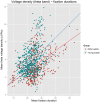Subjective impressions do not mirror online reading effort: concurrent EEG-eyetracking evidence from the reading of books and digital media
- PMID: 23405265
- PMCID: PMC3566074
- DOI: 10.1371/journal.pone.0056178
Subjective impressions do not mirror online reading effort: concurrent EEG-eyetracking evidence from the reading of books and digital media
Abstract
In the rapidly changing circumstances of our increasingly digital world, reading is also becoming an increasingly digital experience: electronic books (e-books) are now outselling print books in the United States and the United Kingdom. Nevertheless, many readers still view e-books as less readable than print books. The present study thus used combined EEG and eyetracking measures in order to test whether reading from digital media requires higher cognitive effort than reading conventional books. Young and elderly adults read short texts on three different reading devices: a paper page, an e-reader and a tablet computer and answered comprehension questions about them while their eye movements and EEG were recorded. The results of a debriefing questionnaire replicated previous findings in that participants overwhelmingly chose the paper page over the two electronic devices as their preferred reading medium. Online measures, by contrast, showed shorter mean fixation durations and lower EEG theta band voltage density--known to covary with memory encoding and retrieval--for the older adults when reading from a tablet computer in comparison to the other two devices. Young adults showed comparable fixation durations and theta activity for all three devices. Comprehension accuracy did not differ across the three media for either group. We argue that these results can be explained in terms of the better text discriminability (higher contrast) produced by the backlit display of the tablet computer. Contrast sensitivity decreases with age and degraded contrast conditions lead to longer reading times, thus supporting the conclusion that older readers may benefit particularly from the enhanced contrast of the tablet. Our findings thus indicate that people's subjective evaluation of digital reading media must be dissociated from the cognitive and neural effort expended in online information processing while reading from such devices.
Conflict of interest statement
Figures






Similar articles
-
Digital reader vs print media: the role of digital technology in reading accuracy in age-related macular degeneration.Eye (Lond). 2013 May;27(5):639-43. doi: 10.1038/eye.2013.14. Epub 2013 Mar 15. Eye (Lond). 2013. PMID: 23492860 Free PMC article.
-
Cognitive engagement during reading on digital tablet: Evidence from concurrent recordings of postural and eye movements.Q J Exp Psychol (Hove). 2020 Nov;73(11):1820-1829. doi: 10.1177/1747021820931830. Epub 2020 Jun 23. Q J Exp Psychol (Hove). 2020. PMID: 32427051
-
Eye movement analysis of reading from computer displays, eReaders and printed books.Ophthalmic Physiol Opt. 2012 Sep;32(5):390-6. doi: 10.1111/j.1475-1313.2012.00930.x. Ophthalmic Physiol Opt. 2012. PMID: 22882151
-
Tablet-Based eBooks for Young Children: What Does the Research Say?J Dev Behav Pediatr. 2016 Sep;37(7):585-91. doi: 10.1097/DBP.0000000000000335. J Dev Behav Pediatr. 2016. PMID: 27575440 Review.
-
The Multisensory Experience of Handling and Reading Books.Multisens Res. 2020 Sep 15;33(8):902-928. doi: 10.1163/22134808-bja10015. Multisens Res. 2020. PMID: 33706265 Review.
Cited by
-
Unveiling Neurocognitive Disparities in Encoding and Retrieval between Paper and Digital Tablet-Based Learning.Brain Sci. 2024 Jan 12;14(1):76. doi: 10.3390/brainsci14010076. Brain Sci. 2024. PMID: 38248291 Free PMC article.
-
Text Materialities, Affordances, and the Embodied Turn in the Study of Reading.Front Psychol. 2022 Mar 14;13:827058. doi: 10.3389/fpsyg.2022.827058. eCollection 2022. Front Psychol. 2022. PMID: 35360633 Free PMC article. Review.
-
Naturalistic reading of multi-page texts elicits spatially extended modulation of oscillatory activity in the right hemisphere.Sci Rep. 2024 Dec 28;14(1):30800. doi: 10.1038/s41598-024-81098-3. Sci Rep. 2024. PMID: 39730469 Free PMC article.
-
Pupil Dilation and EEG Alpha Frequency Band Power Reveal Load on Executive Functions for Link-Selection Processes during Text Reading.PLoS One. 2015 Jun 15;10(6):e0130608. doi: 10.1371/journal.pone.0130608. eCollection 2015. PLoS One. 2015. PMID: 26076026 Free PMC article.
-
Reading digital- versus print-easy texts: a study with university students who prefer digital sources.Psicol Reflex Crit. 2022 May 6;35(1):10. doi: 10.1186/s41155-022-00212-4. Psicol Reflex Crit. 2022. PMID: 35522338 Free PMC article.
References
-
- Rowlands I, Nicholas D, Jamali HR, Huntington P (2007) What do faculty and students really think about e-books? Aslib Proc 59: 489–511.
-
- Rayner K, White SJ, Johnson RL, Liversedge SP (2006) Raeding wrods with jubmled lettres: there is a cost. Psychol Sci 17: 192–193. - PubMed
-
- Liversedge SP, Blythe HI (2007) Lexical and sublexical influences on eye movements during reading. Lang Linguist Compass 1: 17–31.
-
- Bornkessel I, McElree B, Schlesewsky M, Friederici AD (2004) Multi-dimensional contributions to garden path strength: Dissociating phrase structure from case marking. J Mem Lang 51: 495–522.
-
- Bornkessel I, Schlesewsky M (2006) The role of contrast in the local licensing of scrambling in German: Evidence from online comprehension. J Germanic Linguist 18: 1–43.
Publication types
MeSH terms
LinkOut - more resources
Full Text Sources
Other Literature Sources

